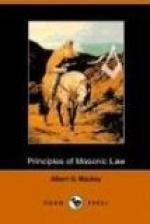The ancient rule was, that when the Grand Master and his officers attended to constitute a new lodge, the Deputy Grand Master invested the new Master, the Grand Wardens invested the new Wardens, and the Grand Treasurer and Grand Secretary invested the Treasurer and Secretary. But this regulation has become obsolete, and the whole installation and investiture are now performed by the Grand Master. On the occasion of subsequent installations, the retiring Master installs his successor; and the latter installs his subordinate officers.
The ceremony of installation is derived from the ancient custom of inauguration, of which we find repeated instances in the sacred as well as profane writings. Aaron was inaugurated, or installed, by the unction of oil, and placing on him the vestments of the High Priest; and every succeeding High Priest was in like manner installed, before he was considered competent to discharge the duties of his office. Among the Romans, augurs, priests, kings, and, in the times of the republic, consuls were always inaugurated or installed. And hence, Cicero, who was an augur, speaking of Hortensius, says, “it was he who installed me as a member of the college of augurs, so that I was bound by the constitution of the order to respect and honour him as a parent."[32] The object and intention of the ancient inauguration and the Masonic installation are precisely the same, namely, that of setting apart and consecrating a person to the duties of a certain office.
The ceremonies, thus briefly described, were not always necessary to legalize a congregation of Masons. Until the year 1717, the custom of confining the privileges of Masonry, by a warrant of constitution, to certain individuals, was wholly unknown. Previous to that time, a requisite number of Master Masons were authorized by the ancient charges to congregate together, temporarily, at their own discretion, and as best suited their convenience, and then and there to open and hold lodges and make Masons; making, however, their return, and paying their tribute to the General Assembly, to which all the fraternity annually repaired, and by whose awards the craft were governed.
Preston, speaking of this ancient privilege, says: “A sufficient number of Masons met together within a certain district, with the consent of the sheriff or chief magistrate of the place, were empowered at this time to make Masons and practice the rights of Masonry, without a warrant of constitution.” This privilege, Preston says, was inherent in them as individuals, and continued to be enjoyed by the old lodges, which formed the Grand Lodge in 1717, as long as they were in existence.




